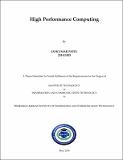Please use this identifier to cite or link to this item:
http://drsr.daiict.ac.in//handle/123456789/594| Title: | High Performance Computing |
| Authors: | Bhatt, Amit Patel, Jaykumar |
| Keywords: | Qualcomm Linux Linaro microsoft azure Computer architecture Amazon Web Services |
| Issue Date: | 2016 |
| Publisher: | Dhirubhai Ambani Institute of Information and Communication Technology |
| Citation: | Jaykumar Patel (2016). High Performance Computing. Dhirubhai Ambani Institute of Information and Communication Technology, vii, 38p. (Acc.No: T00557) |
| Abstract: | Technology today has evolved from the Mainframe computers to laptops to small and smart handheld devices. These smart end devices are accompanied with extremely robust ARM 64-bit processors which are a perfect blend of power andperformance balancing. It becomes extremely important to utilize their capabilitiesto the maximum. The thesis is on High Performance Computing whichexploits the possibilities of performing computationally intensive tasks by clusterformation of easily available commodities off-the-shelf. The high performancecomputing clusters using Linux (Linaro) operating systems based Qualcomm embeddedboards, Linux desktop computers, andWindows desktop computers havebeen created. High Performance Linpack benchmarks are ran on the Linux basedclusters and the expected speedup in performance is obtained thereby allowingformation of a very cheap and high throughput computing cluster using devicesavailable around us and no need of specialized supercomputing environment.This idea of networking cluster formation is further extended to cloud. The samekind of computing cluster has been created on Amazon cloud services and hasbeen successfully tested for its throughput using HPL benchmarks. Now, the ideawas to integrate the local clusters with the clusters on cloud so that the live videoprocessing based computationally and power intensive tasks can be solved locallyfirst and then clusters on cloud can be used when the processing and batterypower of the local devices gets exhausted in real time. Thus, the idea of clusterformation can be extended to the field of IoT for solving small data issues like batterypower and processing power capacity in domains involving applications likeextensive video processing, modelling of complex mathematical equations, solvingcomplex input and computationally intensive machine learning algorithmsand many more applications |
| URI: | http://drsr.daiict.ac.in/handle/123456789/594 |
| Appears in Collections: | M Tech Dissertations |
Files in This Item:
| File | Description | Size | Format | |
|---|---|---|---|---|
| 201411003.pdf Restricted Access | 1.05 MB | Adobe PDF |  View/Open Request a copy |
Items in DSpace are protected by copyright, with all rights reserved, unless otherwise indicated.
